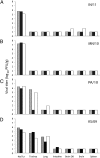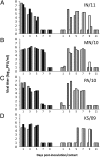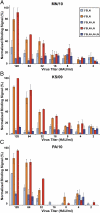Pathogenesis and transmission of swine origin A(H3N2)v influenza viruses in ferrets
- PMID: 22355116
- PMCID: PMC3309732
- DOI: 10.1073/pnas.1119945109
Pathogenesis and transmission of swine origin A(H3N2)v influenza viruses in ferrets
Abstract
Recent isolation of a novel swine-origin influenza A H3N2 variant virus [A(H3N2)v] from humans in the United States has raised concern over the pandemic potential of these viruses. Here, we analyzed the virulence, transmissibility, and receptor-binding preference of four A(H3N2)v influenza viruses isolated from humans in 2009, 2010, and 2011. High titers of infectious virus were detected in nasal turbinates and nasal wash samples of A(H3N2)v-inoculated ferrets. All four A(H3N2)v viruses possessed the capacity to spread efficiently between cohoused ferrets, and the 2010 and 2011 A(H3N2)v isolates transmitted efficiently to naïve ferrets by respiratory droplets. A dose-dependent glycan array analysis of A(H3N2)v showed a predominant binding to α2-6-sialylated glycans, similar to human-adapted influenza A viruses. We further tested the viral replication efficiency of A(H3N2)v viruses in a relevant cell line, Calu-3, derived from human bronchial epithelium. The A(H3N2)v viruses replicated in Calu-3 cells to significantly higher titers compared with five common seasonal H3N2 influenza viruses. These findings suggest that A(H3N2)v viruses have the capacity for efficient replication and transmission in mammals and underscore the need for continued public health surveillance.
Conflict of interest statement
The authors declare no conflict of interest.
Figures




Similar articles
-
Pathogenesis and Transmission of Genetically Diverse Swine-Origin H3N2 Variant Influenza A Viruses from Multiple Lineages Isolated in the United States, 2011-2016.J Virol. 2018 Jul 31;92(16):e00665-18. doi: 10.1128/JVI.00665-18. Print 2018 Aug 15. J Virol. 2018. PMID: 29848587 Free PMC article.
-
Impact of prior seasonal H3N2 influenza vaccination or infection on protection and transmission of emerging variants of influenza A(H3N2)v virus in ferrets.J Virol. 2013 Dec;87(24):13480-9. doi: 10.1128/JVI.02434-13. Epub 2013 Oct 2. J Virol. 2013. PMID: 24089569 Free PMC article.
-
Aerosol Transmission from Infected Swine to Ferrets of an H3N2 Virus Collected from an Agricultural Fair and Associated with Human Variant Infections.J Virol. 2020 Jul 30;94(16):e01009-20. doi: 10.1128/JVI.01009-20. Print 2020 Jul 30. J Virol. 2020. PMID: 32522849 Free PMC article.
-
[Swine influenza virus: evolution mechanism and epidemic characterization--a review].Wei Sheng Wu Xue Bao. 2009 Sep;49(9):1138-45. Wei Sheng Wu Xue Bao. 2009. PMID: 20030049 Review. Chinese.
-
Predicting 'airborne' influenza viruses: (trans-) mission impossible?Curr Opin Virol. 2011 Dec;1(6):635-42. doi: 10.1016/j.coviro.2011.07.003. Epub 2011 Sep 3. Curr Opin Virol. 2011. PMID: 22440921 Free PMC article. Review.
Cited by
-
Swine Influenza Viruses Isolated from 2019 to 2022 in Shandong Province, China, Exemplify the Dominant Genotype.Genes (Basel). 2024 Jun 27;15(7):849. doi: 10.3390/genes15070849. Genes (Basel). 2024. PMID: 39062628 Free PMC article.
-
Utility of Human In Vitro Data in Risk Assessments of Influenza A Virus Using the Ferret Model.J Virol. 2023 Jan 31;97(1):e0153622. doi: 10.1128/jvi.01536-22. Epub 2023 Jan 5. J Virol. 2023. PMID: 36602361 Free PMC article.
-
Swine Influenza Virus Infection Decreases the Protective Immune Responses of Subunit Vaccine Against Porcine Circovirus Type 2.Front Microbiol. 2021 Dec 24;12:807458. doi: 10.3389/fmicb.2021.807458. eCollection 2021. Front Microbiol. 2021. PMID: 35003038 Free PMC article.
-
Pathogenesis and Transmission of Genetically Diverse Swine-Origin H3N2 Variant Influenza A Viruses from Multiple Lineages Isolated in the United States, 2011-2016.J Virol. 2018 Jul 31;92(16):e00665-18. doi: 10.1128/JVI.00665-18. Print 2018 Aug 15. J Virol. 2018. PMID: 29848587 Free PMC article.
-
Influenza A virus transmission via respiratory aerosols or droplets as it relates to pandemic potential.FEMS Microbiol Rev. 2016 Jan;40(1):68-85. doi: 10.1093/femsre/fuv039. Epub 2015 Sep 17. FEMS Microbiol Rev. 2016. PMID: 26385895 Free PMC article. Review.
References
-
- Barker WH, Mullooly JP. Impact of epidemic type A influenza in a defined adult population. Am J Epidemiol. 1980;112:798–811. - PubMed
-
- Thompson WW, et al. Mortality associated with influenza and respiratory syncytial virus in the United States. JAMA. 2003;289:179–186. - PubMed
-
- Dawood FS, et al. Novel Swine-Origin Influenza A (H1N1) Virus Investigation Team Emergence of a novel swine-origin influenza A (H1N1) virus in humans. N Engl J Med. 2009;360:2605–2615. - PubMed
-
- Louie JK, et al. California Pandemic (H1N1) Working Group Factors associated with death or hospitalization due to pandemic 2009 influenza A(H1N1) infection in California. JAMA. 2009;302:1896–1902. - PubMed
-
- Perez-Padilla R, et al. INER Working Group on Influenza Pneumonia and respiratory failure from swine-origin influenza A (H1N1) in Mexico. N Engl J Med. 2009;361:680–689. - PubMed
Publication types
MeSH terms
Substances
Grants and funding
LinkOut - more resources
Full Text Sources
Other Literature Sources
Medical

